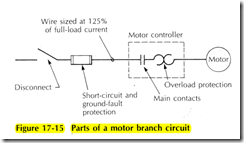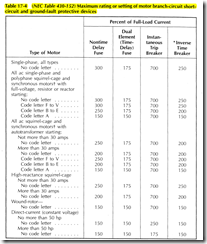A branch circuit supplying a single motor is only subjected to excessive current caused by motor overloads or by ground faults and short circuits. Sometimes, a single overcurrent protective device protects against all three conditions while, in many instances, overload protection and protection from ground faults and short circuits are provided separately. First, consider them separately, and size the short circuit and ground fault protection for the branch circuit. The overcurrent device is either a fuse or a circuit breaker placed at the beginning of the circuit, Figure 17 15.
The short circuit and ground fault protection must be capable of carrying the starting current of the motor, NEC Section 430 52. The maximum rating of a timedelay fuse or an inverse time circuit breaker is determined using NEC Table 430 152 (Table 17 4 in this text). An inverse time circuit breaker is an ordinary circuit breaker which provides short circuit protection, but it will carry an overload for a limited period of time. The code letter given on the nameplate of the motor is needed to determine the maximum size short circuit and groundfault protection. The motor of Figure 17 13 has a code letter J. This is an ac 3 phase squirrel cage motor; therefore from NEC Table 430 152, the maximum size timedelay fuse is 175% of the motor full load current, or 39 A. The motor full load current must be taken from NEC Table 430 150. The maximum size inverse time circuit breaker would be 250% of the motor full load current, or 55 A
The motor short circuit and ground fault protective device should be sized as small as possible without causing nuisance tripping. Remember that the minimum size in the case of a circuit breaker is 1.15 times the full load current of the motor, NEC Section 430 58. The motor of Figure 17 13 is shown in Figure 17 16 with all components sized within the limits of the National Electrical Code. A suggested procedure is to determine the overcurrent protection size, using the value determined in NEC Table 430 152. If the motor is not driving a hardstarting load, then choose the next smaller protective device than the value determined. If this is too small, then choose the next size larger. In no case is the fuse permitted to be sized larger than 225% of the full load current, NEC Section 430 52, Exception No. 2(b). For a circuit breaker, the maximum size is not permitted to exceed 400% for a motor drawing 100 A or less, and 300% for motors drawing more than 100 A, NEC Section 430 52, Exception No. 2(c)
1.75 X 22 A= 38 A
(Use a 35-A or 40-A fuse.)
Circuit breaker:
2.5 X 22 A = 55 A
Use a 50-A or 60-A breaker
Problem 17-2
A single phase, 5 hp 230 V electric motor with nameplate full load current of 26 A drives a normal starting load and has a code letter G. Determine th proper size motor short circuit protective time dela fuse
Solution
Determine the full load current from NEC Table 430 148 and the fuse multiplier from NEC Table 430 152
Full-load current: 28 A
Fuse multiplier: 175%
1. 75 X 28 A = 49 A
Use a 50 A fuse. The minimum wire size is No. 11 AWG copper THWN with a rating of 35 A
For explanation of Code Letter Marking, see Table 430-7(b).
For certain exceptions to the values specified, see Sections 430-52 through 430-54.
*The values given in the last column also cover the ratings of nonadjustable inverse time types of circuit breakers that may be modified as in Section 430-52.
tSynchronous motors of the low-torque, low-speed type (usually 450 rpm or lower), such as are used to drive reciprocating compressors, pumps, etc. that start unloaded, do not require a fuse rating or circuit-breaker setting in excess of 200 percent of full-load current.
Reprinted with permission from NFPA 70-1984, National Electrical Code®, Copyright© 1983, National Fire Protection Association, Quincy, MA. This reprinted material is not the complete and official position of the NFPA on the referenced subject which is represented only by the standard in its entirety.
Problem 17-3
Determine the proper size inverse time circuit breaker to provide ground fault and short circuit protection.
Solution
Circuit breaker multiplier: 250%
2.5 X 28 A = 70 A
Use a 60 A breaker, if possible. If it is too small, then choose a 70 A breaker.
It is permissible to have an overcurrent device sized larger than the allowable ampere rating of the wire. For example, a 70 A circuit breaker can protect a No. 10 AWG copper THWN wire with a maximum rating of 35 A. It must be remembered that the purpose of this circuit breaker is to protect against ground faults and short circuits only. Overload protection not exceeding the ampere rating of the wire is provided usually in the form of thermal overload heaters in the motor starter. As long as properly sized overload protection is provided somewhere in the circuit, the short circuit fuse or circuitbreaker protection is permitted to exceed the ampere rating of the motor branch circuit wire.

